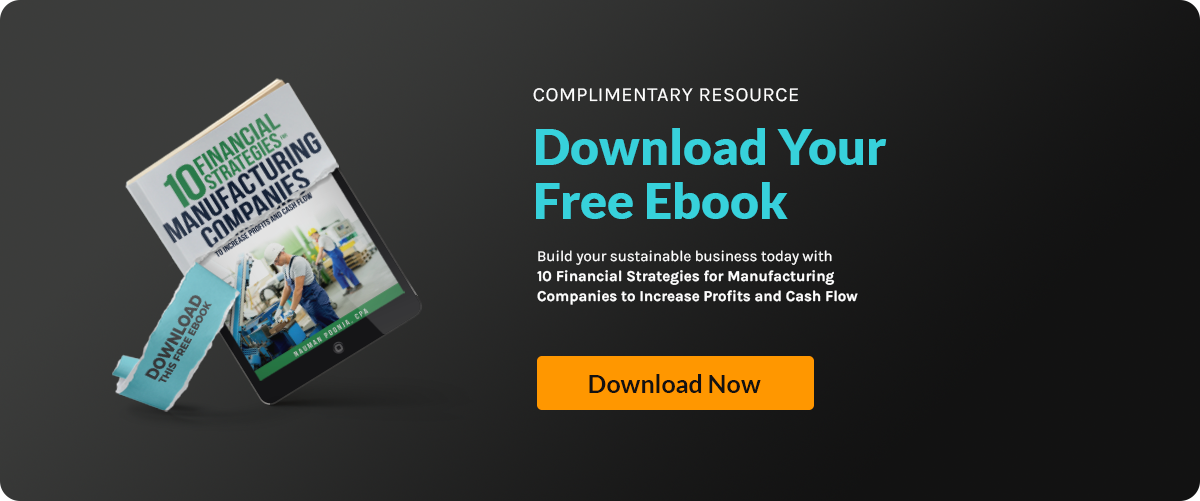Looking for ways to improve your manufacturing business and its finances? Outsourced financial...
Long Term Capital Expenditure Planning in Manufacturing

Every year, manufacturing companies pour billions into capital expenditures (CapEx). In 2023 alone, U.S. manufacturers spent over $201 billion on construction and equipment upgrades, a 70% increase from the previous year. This surge highlights a critical truth: manufacturers must keep pace and plan for the future to thrive.
But how do you ensure these substantial investments indeed pay off?
How can you avoid the pitfalls of overinvestment or underinvestment?
The answer lies in effective long-term CapEx planning. This is about making informed, strategic decisions for years to shape your company's success.
Are you ready to transform your financial planning? Keep reading to uncover essential tips and strategies for mastering long-term capital expenditure planning in manufacturing.
Capital Expenditure Planning Fundamentals
Capital expenditure planning is essential for manufacturing success. It helps executives allocate resources effectively. This ensures that capital investments align with the company’s goals. Proper planning enhances profitability and shareholder value. Below are the fundamentals that guide effective capital expenditure planning:
Needs Analysis: This involves identifying which assets and equipment are necessary for improving growth and efficiency within the company. It helps in understanding the specific investments required to support strategic objectives.
Budgeting: This is about planning how much money will be spent on capital projects, which helps manage cash flow and prevent overspending.
Project Prioritization: This means ranking projects based on their potential return on investment (ROI) and how well they align with the company’s strategic goals. It ensures that the most beneficial projects are given priority.
Financing Evaluation: This helps find the best ways to fund projects without negatively impacting operational budgets.
KPI Monitoring: Tracking key performance indicators (KPIs) involves measuring the success and impact of capital investments. It provides insights into whether the investments are delivering the expected benefits.
Regulatory Compliance: It is critical to ensure that all investments comply with relevant regulations to avoid legal issues. This means understanding and adhering to industry standards and laws.
Integration Planning: This involves smoothly integrating new assets into existing operations. It ensures that new investments fit well within the current system and processes.
Net Present Value (NPV) Assessment: Calculating the NPV of projects helps evaluate their long-term profitability. It provides a clear picture of the expected financial benefits over time.
Virtual Strategies in the Manufacturing Sector
A virtual strategy is the implementation of digital tools and technologies to manage and enhance various business operations remotely. In manufacturing, virtual strategies involve using technologies such as virtual reality (VR), augmented reality (AR), simulation software, and other digital platforms.
Virtual strategies help optimize production, reduce indirect costs, and enhance strategic planning. Here are vital virtual strategies to consider:
1. Invest in Virtual Training
Provide your workforce with virtual training programs to enhance their skills. This reduces indirect costs associated with traditional training methods.
2. Virtual Simulations for Production Capacity
Use virtual simulations to analyze and optimize production capacity. This helps in understanding how much to invest in new equipment.
3. Implement Virtual Reality for Defect Reduction
Virtual reality can help in reducing defects by providing a clear understanding of production processes. This leads to knock-on benefits in quality and efficiency.
4. Strategic Planning Tools
Use virtual strategic planning tools to manage capital spending. These tools help allocate resources effectively and ensure measurable outcomes.
5. Virtual Brainstorming Sessions
Conduct virtual brainstorming sessions to generate innovative ideas; this helps solve problems and improve processes without physical meetings.
6. Analyze Technological Investments
Use virtual tools to analyze whether technological investments are yielding the desired results. This ensures that you are optimizing your capital allocation.
7. Virtual Maintenance Management
Implement virtual maintenance management systems to track equipment performance. This reduces downtime and extends the lifespan of assets.
8. Remote Monitoring Systems
Invest in remote monitoring systems to keep an eye on production processes. This helps manage capital spending and maintain efficiency.
Financial Reporting for Manufacturing Success
You might not always notice the need for financial reporting in daily operations, but it's crucial for long-term success. Accurate financial reporting provides clarity and helps in making informed decisions. It supports systematic budgeting and ensures transparency in the manufacturing industry. Here’s how financial reporting can make a difference in crucial situations:
Situation 1: Budgeting Process Overhaul
Imagine your company is planning a significant overhaul of its budgeting process over the next two to three years. This transformation aims to improve cash flow management and ensure long-term sustainability. The goal is to create a more rigorous and systematic approach to financial planning.
Financial Report's Role:
They provide detailed insights into the company’s financial health, essential for effective budgeting. Accurate reports allow executives to make wise decisions about resource allocation, ensuring that every dollar is spent efficiently. Transparency in financial reporting builds trust among stakeholders, which is crucial for manufacturing success. Companies can use comprehensive financial data to plan better, reduce waste, and enhance profitability.
Situation 2: Capital Investment Decisions
Your manufacturing company is considering a significant capital investment in new machinery. This investment could enhance production capacity and efficiency. However, a thorough analysis is required to ensure that it will have long-term benefits.
Financial Report's Role:
Financial reports provide the necessary data to analyze potential returns on capital investments. They help assess the new machinery's economic feasibility and expected cash flow impact. Executives can make informed decisions by examining past financial performance and projecting future gains. This rigorous analysis ensures that investments align with strategic goals and contribute to manufacturing success.
Situation 3: Sustainability Initiatives
The company aims to implement sustainability initiatives to reduce its environmental footprint. This includes investing in energy-efficient technologies and sustainable practices. The challenge is to integrate these initiatives while maintaining financial stability.
Financial Report's Role:
Financial reports are essential in evaluating the cost and benefits of sustainability initiatives. They clearly understand current expenses and potential savings from sustainable investments. Detailed financial data helps allocate funds efficiently and monitor the financial impact over time. This systematic approach ensures that sustainability efforts are financially viable and contribute to the company’s long-term success.
Financial Insights for Maximizing Manufacturing Returns
Expert insights can provide valuable guidance for manufacturing companies aiming to maximize returns. Here are three expert opinions on financial strategies to enhance profitability and efficiency in the manufacturing sector:
John Coykendall, Deloitte LLP
John Coykendall emphasizes the importance of adopting smart factory solutions and digital transformations. He notes that 86% of manufacturing executives believe these technologies will be crucial for competitiveness in the next five years. Implementing innovative factory solutions can optimize production processes, reduce costs, and improve overall efficiency. Coykendall also highlights the role of the industrial metaverse in increasing labor productivity by 12%, which can significantly impact manufacturing returns.
West Monroe Partners
According to West Monroe Partners, developing digital data strategies is essential for driving profitability and efficiency. They suggest that manufacturers focus on integrating advanced technologies such as artificial intelligence (AI) and predictive analytics. These tools help optimize supply chain management and production processes, leading to better decision-making and cost savings. The integration of these technologies can streamline operations and enhance the overall financial performance of manufacturing companies.
David Stahl, Partner at Plante Moran
David Stahl advises manufacturers to maintain a disciplined investment approach and review their portfolios regularly. This includes optimizing yield strategies and ensuring that retirement plan contributions are maximized. They recommend thoroughly assessing financial strategy to ensure that capital is allocated effectively and long-term targets are met. This disciplined approach helps manage risks and capture growth opportunities.
Optimize Long-Term Capital Expenditure with Accounovation
Understanding and planning capital expenditures is crucial for sustained growth in the manufacturing industry. Many companies need clearer financial insight to upgrade equipment. Even the most advanced facilities can achieve their full potential with a solid financial strategy.
Accounovation offers comprehensive accounting solutions that help you master your finances and allocate resources efficiently. By optimizing your capital expenditure planning, we ensure your investments drive growth and profit.
Reach out to Accounovation through our website and maximize your business’s financial potential today.







